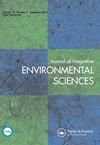Effect of rice cultivars on yield-scaled methane emissions in a double rice field in South China
IF 3.5
4区 环境科学与生态学
Q3 ENVIRONMENTAL SCIENCES
Journal of Integrative Environmental Sciences
Pub Date : 2015-12-18
DOI:10.1080/1943815X.2015.1118388
引用次数: 16
Abstract
Abstract Rice cultivar is the most influential factor affecting methane emissions from double rice fields. A two-year field experiment was conducted at Huizhou, Guangdong province, South China, to identify from among nine cultivars those cultivars with high-yield potential and lower yield-scaled methane emissions (YSMEs). Methane emissions were measured using the static chamber – gas chromatograph method. Results indicate that the cultivars Qihuazhan (QH), Yexianzhan 8 (YX8) and Yue’erzhan (YE) provide higher rice grain yield (8.69%) with lower YSME (30.27%) compared to the other six cultivars (Yexianzhan 6, Yuejingsimiao, Hefengzhan, Huangsizhan, Huangruanzhan and Huangxiuzhan) (p < 0.05). In particular, QH has the highest yield potential (6777 kg ha−1) and lowest methane emission intensity (0.36 kg kg−1 yield) capacity. Methane emissions from the double rice field was found to be significantly (p < 0.05) and positively correlated with tiller number, culm biomass and soil organic matter, dissolved soil organic carbon and total carbon content, but negatively correlated (p < 0.05) with rice harvest index (HI), and root and panicle biomass, suggesting that organic source strength provides the substrate of methane production while the oxidation potential in the rhizosphere and the methane transport capacity of rice roots and culm dominate the emissions of methane from soil to the atmosphere. Multivariate decision regression tree (DRT) analysis showed a significant class difference between QH, YX8 and YE with the other six cultivars. These three cultivars are suitable for promotion of low carbon agriculture in South China. DRT analysis also successfully illustrated a potential way to identify rice varieties for low YSME by decisive parameters of tiller number (<15), HI (>0.43) and nitrogen assimilation of leaves (<40). These findings suggest that optimization of rice cultivars may represent an effective way to address both food demand and climate change concerns by improving rice yields while simultaneously minimizing the impact of climate change per unit yield.水稻品种对华南双季稻田甲烷排放量的影响
水稻品种是影响双稻田甲烷排放的最主要因素。在广东惠州进行了为期2年的大田试验,从9个品种中筛选出高产潜力低产量规模甲烷排放(YSMEs)的品种。采用静室气相色谱仪法测定了甲烷排放量。结果表明:七花展(QH)、叶鲜展8号(YX8)和月二展(YE)的籽粒产量(8.69%)高于其他6个品种(叶鲜展6号、月粳四苗、合丰展、黄四展、黄柔展和黄绣展)(p < 0.05);特别是,QH具有最高的产量潜力(6777 kg ha−1)和最低的甲烷排放强度(0.36 kg kg kg−1)。双稻田甲烷排放量与分蘖数、茎生物量、土壤有机质、土壤溶解有机碳和全碳含量呈显著正相关(p < 0.05),与水稻收获指数、根穗生物量呈显著负相关(p < 0.05);表明有机源强度是甲烷产生的基础,而根际氧化电位和水稻根和茎的甲烷运输能力是甲烷从土壤向大气排放的主导因素。多变量决策回归树(DRT)分析显示,QH、YX8和YE与其他6个品种的分类差异显著。这三个品种适合在华南地区推广低碳农业。DRT分析还成功地通过分蘖数(0.43)和叶片氮同化(<40)这两个决定性参数来鉴定低YSME水稻品种。这些发现表明,优化水稻品种可能是解决粮食需求和气候变化问题的有效途径,既能提高水稻产量,又能最大限度地减少气候变化对单产的影响。
本文章由计算机程序翻译,如有差异,请以英文原文为准。
求助全文
约1分钟内获得全文
求助全文
来源期刊

Journal of Integrative Environmental Sciences
ENVIRONMENTAL SCIENCES-
CiteScore
3.90
自引率
0.00%
发文量
13
审稿时长
>12 weeks
期刊介绍:
Journal of Integrative Environmental Sciences (JIES) provides a stimulating, informative and critical forum for intellectual debate on significant environmental issues. It brings together perspectives from a wide range of disciplines and methodologies in both the social and natural sciences in an effort to develop integrative knowledge about the processes responsible for environmental change. The Journal is especially concerned with the relationships between science, society and policy and one of its key aims is to advance understanding of the theory and practice of sustainable development.
 求助内容:
求助内容: 应助结果提醒方式:
应助结果提醒方式:


